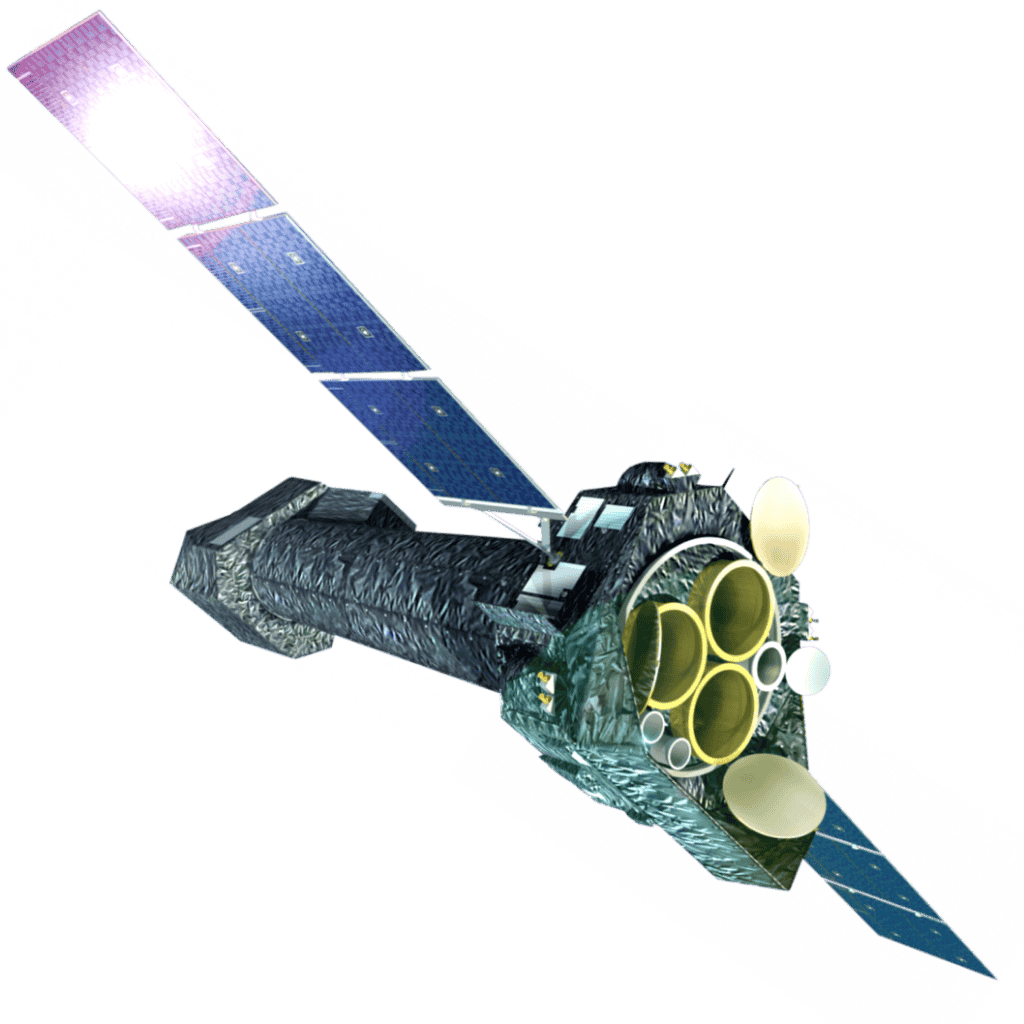XMM-Newton
X-ray Spectroscopist
High-throughput X-ray telescope for studying cosmic sources

USPs
- Three telescopes with 58 nested mirrors for high-throughput X-ray spectroscopy
- Studies black holes, neutron stars, and galaxy clusters
- Complements Chandra with detailed chemical analysis
- European Photon Imaging Cameras (EPIC) for broad energy coverage
- Revealed the chemical composition of supernova remnants
- Long uninterrupted observations due to highly elliptical orbit
- Discovered millions of X-ray sources, expanding the cosmic catalog
Major Milestones
- 1999-12-10: Launched from Kourou, French Guiana, aboard an Ariane 5 rocket, marking the start of its mission as the most powerful X-ray telescope ever placed in orbit.
- 1999-12-13: Reached its 48-hour elliptical orbit, enabling long-duration observations with a perigee of 7,000 km and apogee of 114,000 km.
- 2000-02-15: Completed the deployment of its three X-ray telescope mirror modules, showcasing the innovative electroformed nickel mirrors.
- 2000-06-01: Began scientific operations, delivering the first X-ray observations of celestial objects with its European Photon Imaging Cameras (EPIC).
- 2001: Published initial results, including detailed studies of star-forming regions and galaxy clusters, establishing its scientific impact.
- 2013: Measured the rotation rate of the supermassive black hole in NGC 1365, providing insights into its growth history through X-ray emissions.
- 2019: Celebrated 20 years in space, having contributed to over 5,600 scientific papers and detected more than a million X-ray sources.
- 2024-12-10: Marked 25 years of operation, highlighting discoveries like X-ray flares from black holes and sloshing gas in the Perseus cluster.
- 2025-04: Detected a massive filament of hot gas in the Shapley Supercluster, contributing to the discovery of 'missing' matter in the universe.
- 2025-07-11: Released new animations celebrating 25 years, showcasing its ongoing role in studying galaxy clusters and solar system planets.
Cosmic Portrait
XMM-Newton: Probing the X-ray Universe
XMM-Newton, launched by the European Space Agency (ESA) in 1999, is one of the most powerful and enduring X-ray observatories ever built. Officially named the X-ray Multi-Mirror Mission, this space telescope is designed to detect high-energy phenomena across the universe that are invisible to traditional optical instruments.
- Unique Design: XMM-Newton houses three advanced X-ray telescopes, each made up of 58 finely nested mirror shells. This unique structure allows it to collect an enormous number of X-ray photons, enabling high-resolution imaging and spectroscopy of extremely faint and distant sources.
- Advanced Spectroscopy: Unlike some X-ray observatories that focus solely on imaging, XMM-Newton excels at X-ray spectroscopy, allowing astronomers to analyze the elemental composition, temperature, velocity, and physical conditions of objects such as black holes, galaxy clusters, and neutron stars.
- Orbit and Efficiency: The satellite follows a highly elliptical orbit that stretches up to 114,000 km from Earth. This trajectory ensures long, uninterrupted observations of cosmic targets, minimizing interference from Earth’s radiation belts and maximizing exposure time.
Scientific Contributions and Legacy
Now in its third decade of operation, XMM-Newton continues to make transformative discoveries. It has helped scientists study the superheated gas that fills clusters of galaxies, trace the echoes of massive stellar explosions, and investigate the violent environments around black holes and pulsars.
By dissecting the X-ray signatures of celestial objects, XMM-Newton uncovers the chemical fingerprints of elements such as iron, oxygen, and silicon—providing critical insight into the life cycles of stars and the large-scale structure of the universe. These observations help map how matter flows and transforms in some of the most extreme environments known to science.
Working Alongside Chandra
XMM-Newton often works in tandem with NASA’s Chandra X-ray Observatory, complementing its ultra-precise imaging with broader-field, high-throughput spectral capabilities. While Chandra is known for its exquisite angular resolution, XMM-Newton offers unmatched sensitivity for faint sources and spectral diagnostics, making them a dynamic duo in high-energy astrophysics.
The observatory has also been instrumental in studying mysterious cosmic phenomena like ultraluminous X-ray sources (ULXs), quasars, and even the diffuse background radiation from unresolved cosmic sources. Its data archives remain a treasure trove for ongoing and future research, ensuring that XMM-Newton’s impact will continue for decades.
XMM-Newton is a cosmic chemist, revealing the elements forged in the hearts of stars.
With its remarkable longevity, rich dataset, and continued scientific returns, XMM-Newton stands as a cornerstone in humanity’s quest to understand the high-energy universe—where black holes feed, stars collapse, and the cosmos burns brightest in X-rays.
Fun Fact
XMM-Newton can detect the chemical makeup of distant stars!